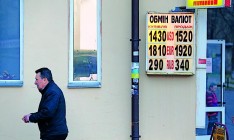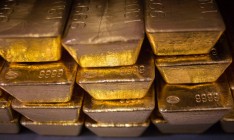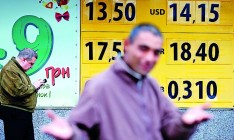Economy
ShortageUkrainians transferred half of their foreign currency purchases into the grey zone

In September Ukrainians bought US $264.6 mn more foreign cash than they sold. The total net purchase of foreign currency decreased by 2.6 times compared to the same month last year. As a rule, autumn is a high season for the Ukrainian currency market when demand traditionally increases, thus putting pressure on exchange rates. So, in September of 2013 people increased their net purchases of foreign currency by almost 5 times compared to August of the same year and in the same months in 2012 and in 2011 this figure increased by 2.5 times. But this year the situation is developing along some rather extraordinary scenario.
Motives of crime
The NBU could take credit for the current situation. On September 23 the regulator reduced the amount of limitation on the sale of foreign cash to one individual during one business day from UAH 15,000 to UAH 3,000 equivalent to US $1,147 to US $230 at the average exchange rate. However, an exception was made for those who have foreign currency loans – the restriction does not apply to purchases of foreign currency for the repayment of loans. “We expect a sharp drop in demand,” General Director of the Department of Monetary Policy at the NBU Olena Shcherbakova informed.
The intentions were right, but the actual situation on the currency market did not improve. The effect of restrictions was not as significant as anticipated by the NBU, even on the legal market. Demand and the ceiling of purchases of hard currency should have fallen fivefold, according to Shcherbakova’s forecasts. Instead, compared to August the aggregate demand fell by only 7.6%, while the net demand increased by 34%.
Even a week before and after the updated limitation the effect was worse than expected. For example, Shcherbakova said in the period September 1–22 net purchases of foreign currency amounted to US $230 mn, which is on average approximately US $73.2 mn a week. Consequently, over the last eight days of the month this figure was US $34.6 mn and this week it was US $30.3 mn. So, thanks to the increased restrictions the average net purchase decreased only by half.
The present decrease in the officially registered demand only indicates that Ukrainians are increasingly exploiting the black market for the purchase of hard currency as the NBU forced the demand there through its administrative measures. “Due to this (restriction – Ed.), the cash currency market has finally moved into the grey zone and currently a system of several parallel exchange rates is functioning in Ukraine. In its turn, the NBU has lost its capacity to control and influence the foreign exchange market,” says Deputy Head of the Federation of Employers of Ukraine Dmytro Oliynyk. For example, on 15 October with the official exchange rate of UAH 12.95/USD and the rate of UAH 13.05/USD on the interbank market, amounts of hard currency higher than US $1,000 were sold on the black market in Kyiv at the rate of UAH 13.85/USD.
Scale of the disaster
The first sign of the NBU’s undervaluation of the public demand for currency is a large gap between the net demand today and in similar periods, when the Ukrainian currency experienced rapid devaluation or the government was preparing for elections. A similar situation was observed in the country in the autumn of 2008, says Head of the Analytical Department at SP Advisors Vitaliy Vavryshchuk. It was in October–December 2008 that the hryvnia experienced sharp devaluation of 59%, down to the official rate of UAH 7.70/USD. After the collapse of the ruling “orange” coalition, the early parliamentary elections were scheduled on December 2008, which were never held. The economy plummeted by 7.8% in the last quarter of 2008 and an outflow of deposits was observed since October 2008. Fortunately, there was no war in Ukraine at that time. During that period the peoples’ net demand for foreign currency was several times higher than it is today. In September 2008, the net purchase of foreign currency by Ukrainians was US $1.3 bn, in October it was US $938 mn. “Consequently, today at least US $600 mn of net demand is satisfied in the grey market,” says Vavryshchuk. Seeing as in 2008 there also was a shadow market, at the time official estimates of the actual demand for hard currency were underestimated. Therefore, today only a third of operations for the purchase of currency are legal and reported.
Since then the structure of the economy has changed substantially and a net public demand for hard currency at the beginning of this year can be viewed as a clear indicator of the volume of the actual foreign exchange market, says Head of the Analytical Department at Concorde Capital Oleksandr Parashchiy. At that time, the hryvnia was already beginning to rapidly devaluate – during the first quarter the exchange rate dropped by 38% to UAH 11,43/USD, but the opportunity to buy it on the cash market was not so stringently restricted as is the case today. Also, the peak of political uncertainty was reached in February. In those months the peoples’ net demand for hard currency was several times higher than the demand in the latest months. In January of this year the figure was US $659 mn and in February it jumped to US $783 mn. Based on these figures, it can be said that today only half currency exchange transactions are legal. At the same time, Parashchiy notes that in the fall months the demand for currency is traditionally higher. This also indicates that at present more than half of purchases of foreign currency remain in the shadows.






 of the agreement of syndication with Financial Times Limited are strictly prohibited. Use of materials which refers to France-Presse, Reuters, Interfax-Ukraine, Ukrainian News, UNIAN agencies is strictly prohibited. Materials marked
of the agreement of syndication with Financial Times Limited are strictly prohibited. Use of materials which refers to France-Presse, Reuters, Interfax-Ukraine, Ukrainian News, UNIAN agencies is strictly prohibited. Materials marked  are published as advertisements.
are published as advertisements.